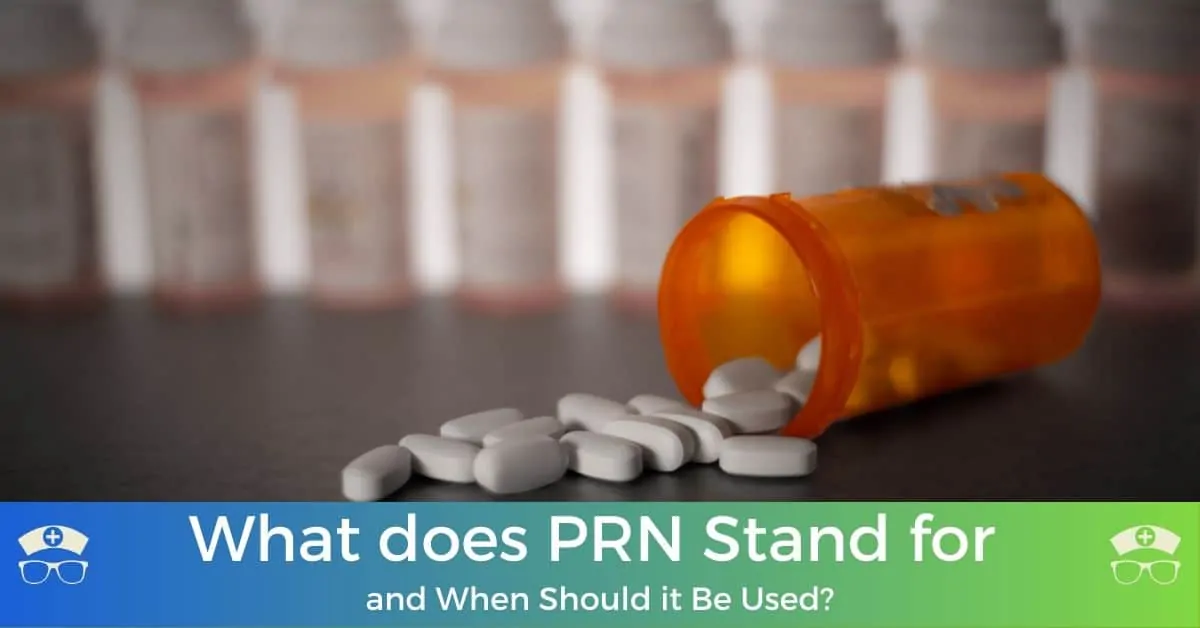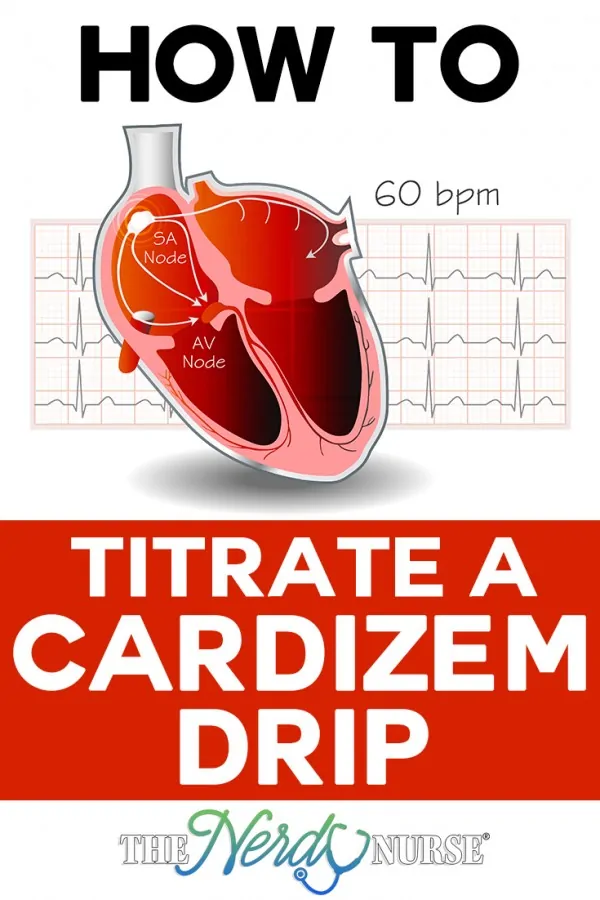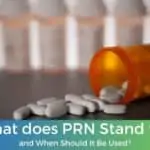Why would someone ask what does PRN stand for? Well… there are a lot of reasons. A patient could have overheard a doctor telling a nurse to get pain meds to a patient PRN. A nusing student could be looking up abbreviations before clinical to ensure they know all the terms they might hear on the floor. Or, a high school student could be guessing that PRN means “per rectum now” and their teacher must Google the term “What does PRN mean” in front of the class to show the student that PRN actually peans “Pro Re Nata”, which means “as needed”.
That last one is based on a true story, by the way. It happened in my son’s high school class, and how funny it was when his mom’s nursing blog popped up with the answer to the class’s medical abbreviation.
So.. What does PRN mean in Medical Terms?
PRN means “as needed.”
Typically PRN is used in the contenxt of medications, but in the hospital it can also be used in other instances such as dressing changes or wound cleaning. For example, a nurse would perform a PRN dressing change when a dressing is saturated.
PRN medications are taken only when needed, such as for pain after surgery, occasionally for nausea, or during a particularly stressful time for anxiety. Typically, there are defined guidelines for when the medication should be taken as well as a minimum time frame between each dose. For example, pain medication can typically be only taken every 4-6 hours, to prevent overdose.
What does PRN Stand for?
I did terribly in college Latin, as much as I tried. But let’s take a little Latin lesson here: PRN is from the Latin term “Pro Re Nata”, which literally translates into English “as needed”. We frequently utilize this “as needed” terminology with medicine, and nurses daily hand out PRN medications for a variety of different reasons. Very often, nurses get their clues that the PRN medication is needed from their clinical assessment of their patient, in varying degrees of subjective and objective information that is gathered.
PRN Medical Abbreviation and Meaning
PRN is a medical abbreviation is one of the most common abbreviations used in healthcare along with Bid in nursing. It is written by physicians on prescriptions, nurses in nurse’s notes, and other staff to describe things that can or have been completed “as needed.”
PRN Nurse or PRN Position
Nursing jobs can also be referred to as a “prn position.” The same rules apply as PRN medications. A nurse who accepts a PRN position is utilized as needed. Some PRN positions have minimum hours, but generally, the days and times are flexible and based on the employer’s needs. A nurse may be required to pick up a PRN shift once a month to maintain her status in the temporary nurse pool or they may just work as needed to assist with staffing shortages.
Full Time Nurses
Most people are familiar with full-time nurses. These are nursing professionals who work around 40 hours a week at the same employer in full-time positions. These nursing positions typically include benefits and requirements to work a standard or rotating schedule. There is minimal flexibility. You would typically call nurses who work in these positions regular staff or a full-time employee. Traditionally, thsee nurses most commonly work in a hospital setting.
Healthcare facilities typically have a set hourly rate cap that full time nurses are eligble for with limited room for negptiation.
Diem Nurse or PRN Nurse
Nurses who work on an as-needed basis are referred to as PRN nurses or diem nurses. These nurses typically do not have standard benefits or required working hours. They can work in a variety of environments, including medical facilities, nursing homes, and more.
PRN nurses typically have higher hourly wages, little or no employee benefits, and more flexibility with their personal life and their family life. The increase in the hourly pay rate and the flexible schedules are enough for registered nurses and practicals to transition from a regular work schedule.
PRN Nursing Freedom and Flexibility
PRN nursing staff also have the ability to negotiate their salary, bonuses, and other incentives to work. They do not have the strain of teh golden handcuffs of employer benefits. So they are free to go from hospital to hospital as a travel nurse
My friend Kelsey at Whole Life Nurse, helps nurses transition into more flexible work in her Craft Your Dream Career community. If PRN nursing sounds interesting to you, it’s worth checking out.

PRN Abbreviation in Other Use Cases
Nurses and other medical professionals will notoriously use medical abbreviations and other clinical jargon outside of the hospital. When writing notes for themselves or even their family, nurses will often write the PRN abbreviation to indicate to do something “as needed.”
When Should “PRN” Be Used in the Medical World
Now that you had your Latin lesson for the day and you feel comfortable in answering your patient when she asks “So, what does PRN stand for?”, we now need to go on and discuss when PRN should be used in the medical field.
PRN Medications
As previously mentioned, we have to hand out PRN medications when our assessment warrants it. If the patient is having chest pain, sublingual nitroglycerin (an “as needed” medication) would be given, as well as morphine. If the patient is nauseated, the PRN order for Zofran or Phenergan would be warranted. The beauty of PRN medications is that nurses get a standing order for some of the most needed and routine medications based on various procedures and conditions.
They are not scheduled (we would hardly want our pain-free patient receiving morphine scheduled every four hours), but to administer it as the situation requires it. PRN orders provide nurses with autonomy and authority to decide whether a patient should receive a certain medication and does not mean that a walkie-talkie patient should receive 2mg of morphine while they are sleeping, just because it was 2 hours after the last dose. (Even if they beg you to give it to them even if they are asleep.)
Common PRN Medications
Medications or the following conditions are often scheduled on PRN basis:
- pain
- nausea
- itching
- insomnia
PRN Example
Let’s take a look at a specific example. Our patient just got out of surgery and had their gallbladder removed. The patient states they have 8/10 pain at the incision site. When looking at our orders, we see that we have a morphine order that reads “2mg iv morphine every 4 hours as needed for a pain level 7-10”. It’s in the nursing scope of practice to assess the patient and administer medications that they would deem necessary in light of assessment findings. So if the patient says their pain is 8/10, and they are alert, then we shall give 2mg iv morphine. Now if their pain is not relieved and we come back in an hour and it’s still 8/10, we cannot give another 2 mg of iv morphine because we can only give it every four hours as needed (PRN).
Despite what my patient once told me that she needed it every ten minutes, there are still parameters for PRN medications. They are there to keep patients safe. With the post-cholecystectomy patient, it would be appropriate to collect a fresh set of vital signs and call the physician and alert them that the patient is still experiencing pain to see if a one-time order for unrelieved pain would be available.
Nursing Things You have to Memorize
So often as nurses, we can be on cruise control just going through the motions of our day. Sometimes we forget or we don’t really know what our common medical acronyms mean or why they mean what they do. It’s not until a patient asks us what something means that we start to feel a little silly when we’re stammering for an answering, as well as simultaneously kicking ourselves thinking “I should probably know that one.” Years ago, a patient asked me “You say that I can get morphine PRN, but what does PRN stand for?” I fumbled a little bit and stuttered out “You can get it as you need it.”
It was like that time I had to confirm how many CC’s are in an ounce. In this new example, with the Morphine, the patient was certain she needed every 10 minutes and wanted to debate the meaning of PRN with me. I had to explain that it was only available every two hours, but the inclusion of the “PRN” really threw her. “But you said I can get it as I need it!!!” she yelled at me. It wasn’t as simple at a TID medication. Needless to say, that day exhausted me and reminded me that sometimes we all need a little refresher on this oh-so-common acronym. Medical acronyms can often be like nursing symbols. We think we know what they stand for but often don’t really know the history of them or even the history of the nursing profession. Hopefully, by the end of this post, you will be able to confidently respond when someone asks you “What does PRN mean?”
Some Acronyms You Just Have to Know
The PRN medical abbreviation is a standard in healthcare.
Knowing what certain acronyms mean in your nursing profession are vital. They help you “speak the language” and ultimately to be a better nurse to help your patient make a full recovery! It can also help to keep your patients safe and confident in your care, as you’re able to interpret their orders quickly and properly explain to them (especially during discharge) what exactly PRN means, so they will know how they should take their medications. It is essential that our patients are aware of what medications need to be scheduled, and which ones they have a little more liberty with (though we must always emphasize the constraints they have with their as needed medications).
We would never want our patients to not fully understand, as that could mean that they are living in pain or discomfort, or worse take more medications than they should and end of in distress. Luckily with our PRN definition, a little Latin goes a long way, and our patients may not exactly remember that PRN stands for “Pro Re Nata” but they will remember the kind nurse that educated them and showed them how to take their medications appropriately.
The Latin pro re nata is commonly used, but not every understands the linguistic origins. But now, you do!
So the next time someone says “what does PRN stand for,” you’ll have a detailed explanation of what it is and why on earth those 3 letters are so common in healthcare.
More Medical Abbreviations:
- What Does the NPO Medical Abbreviation Mean?
- EtOH Medical Abbreviation – EtOH Meaning and Application in Nursing
- What Does Bid Mean in Nursing?
Do you struggle with Lab Values?
Get this secret weapon to be the lab value expert at the nurse’s station.
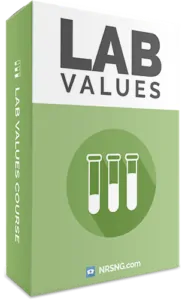
Download Nurse Bingo Today!
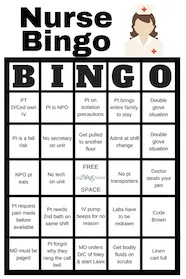
Liven up any shift with a fun game of bingo. See who can fill a row first!
Fill a whole card and lose grip with reality.
Your privacy is protected. We will never spam you.

